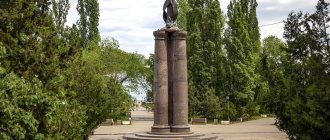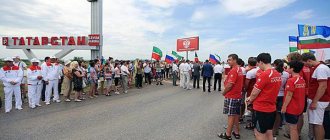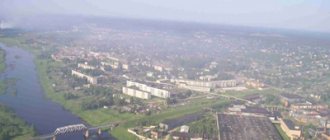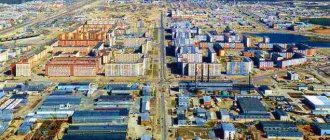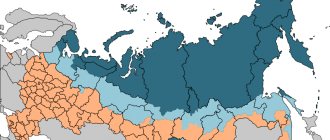Dear residents of the city of Taganrog. And also his guests!!
In this article, we will try to highlight the main districts in the city of Taganrog, which will allow you to understand more clearly, in detail and in detail: what districts the city of Taganrog is divided into, and what subdistricts exist in the main districts of the city of Taganrog.
This is important, since the actual zoning of the city of Taganrog differs from the legal, “standard” one - approved by the General Plan of the city!!
According to the city general plan, there are 5 districts of the city (see below):
- Central area - Located from the port to the lane. Smirnovsky. It houses the vast majority of historical, cultural and architectural monuments with a strict regime of protection and restoration. It allocates an area with regulated development while maintaining the planning grid - from the street. Chekhov, per. Gogolevsky and southwest to the coast.
- Northern district Located north of the railway from the New Railway Station. The unofficial name of the area is SZhM.
- Western district – Located from Chucheva street, from st. Transport and along the Mariupol highway and the airfield of the military unit and airfield 325 ARZ
- The eastern region is a very large area.
- Northwestern region - located east of the Taganrog - Pokrovskoye road - Pokroskoye is the main village of the Neklinovsky district, Rostov region (District center)!!.
- There is also the Neklinovsky district - a huge formation in territory, legally an autonomous entity "Neklinovsky district of the Rostov region" with its center in the village of Pokrovskoye - adjacent to the city of Taganrog, but, basically, economically and infrastructurally completely “tied” to the municipal formation of the city of Taganrog! !
Below we will carry out the zoning of the city of Taganrog, which is the guideline for most citizens and guests coming to the city of Taganrog:
We are sure that this will greatly help everyone choose real estate in Taganrog more easily and correctly, and will also help residents of other regions of the Russian Federation who come to Taganrog on vacation!!!
general information
First, let's get acquainted with the most general information about this locality.
Where is the city of Taganrog and what is it like? Its location is the shore of the bay of the same name in the Azov Sea, southwest of the Rostov region. Taganrog is a large scientific, cultural and industrial center, a leading seaport in the Russian south. Its population is 277.3 thousand people, according to this indicator it is the second in the region. Ukraine is 50 kilometers away, the territory has an area of more than 80 km². The regional center is 77 km away. The city is located on a magnificent cape, which protrudes quite far into the sea and is surrounded by water on three sides. Not far from it are the industrial cities of Azov and Bataysk, as well as the Ukrainian seaport of Mariupol.
Map
| Taganrog: maps |
Taganrog: photo from space (Google Maps) Taganrog: photo from space (Microsoft Virtual Earth)
| Taganrog. Nearest cities. Distances in km. on the map (in brackets along roads) + direction. Using the hyperlink in the distance , you can get the route (information courtesy of the AutoTransInfo website) | |||
| 1 | Nikolaevka | 12 () | NW |
| 2 | Pokrovskoye | 23 (24) | WITH |
| 3 | Kagalnik | 33 (100) | SE |
| 4 | Matveev Kurgan | 39 (45) | WITH |
| 5 | Azov | 39 (92) | IN |
| 6 | Chaltyr | 43 (51) | IN |
| 7 | Kuleshovka | 49 () | IN |
| 8 | Rostov-on-Don | 60 (67) | IN |
| 9 | Bataysk | 63 (79) | IN |
| 10 | Samara | 66 (102) | SE |
| 11 | Staroshcherbinovskaya (Krasnodar region) | 66 (186) | YU |
| 12 | Kuibyshevo | 67 (79) | WITH |
| 13 | Aksai | 71 (84) | IN |
| 14 | Novobataysk | 73 (113) | SE |
| 15 | Dawn | 74 () | IN |
| 16 | Rodionovo-Nesvetaiskaya | 74 (115) | NE |
| 17 | Yeysk | 74 (210) | SW |
| 18 | Shirochanka (Krasnodar region) | 75 () | SW |
| 19 | Starominskaya (Krasnodar region) | 75 (182) | YU |
| 20 | Olginskaya | 77 () | IN |
| 21 | Novoshcherbinovskaya (Krasnodar region) | 84 () | YU |
| 22 | Kirovskaya | 89 (101) | IN |
| 23 | Kushchevskaya (Krasnodar region) | 90 (146) | SE |
| 24 | Novocherkassk | 92 (113) | IN |
| 25 | Krivyanskaya | 96 () | IN |
| 26 | Persianovsky | 96 (123) | IN |
| 27 | Novoshakhtinsk | 97 (142) | NE |
| 28 | Cossack Camps | 98 () | NE |
| 29 | Novoderevyankovskaya (Krasnodar region) | 99 () | YU |
| 30 | Novominskaya (Krasnodar region) | 99 (209) | YU |
a brief description of
Located on the northeastern shore of the Taganrog Bay of the Sea of Azov, 67 km west of Rostov-on-Don. Port. Railway station.
Taganrog is an important industrial center in southern Russia.
In the Taganrog region there is a climatic resort area of the Taganrog Bay.
Territory (sq. km): 80
Information about the city of Taganrog on the Russian Wikipedia website
Historical sketch
In 1698, in the Taganrog tract, Peter I founded the Trinity Fortress (named after the church consecrated in the name of the Holy Trinity) and a port, which served as the base of the Russian Azov navy. The name given to the fortress by Peter I did not catch on; it was usually called Trinity-on-Taganrog, although Taganrog-city and simply Taganrog were also used. The name of the tract is from the Turkic tagan “stand for a cauldron, tripod” and the Russian rog “cape”, i.e. “the cape on which there was a fire stand (lighthouse).” From the middle of the 18th century. The name Taganrog is assigned to the city.
In February 1712, under the terms of the peace treaty with Turkey, concluded as a result of the unsuccessful Prut campaign of Russian troops (1711), the fortress was destroyed. In 1769, during the Russian-Turkish War of 1768-74, the northeastern part of the Azov Sea coast was occupied by Russian troops and, according to the Kuchuk-Kainardzhi Peace Treaty (1774), was finally annexed to Russia.
The restored Taganrog in 1775 was officially approved as a city in the Azov province of the Azov province. After the founding of Sevastopol (1783), Taganrog lost its significance as a naval base and from the 1780s became a major foreign trade port in southern Russia. Since 1783, it has been a district-free city of the Yekaterinoslav governorship.
Emperor Alexander I died in Taganrog on November 19 (December 1), 1825.
During the Crimean War of 1854-56, Taganrog was attacked by the Anglo-French fleet in 1855.
In 1856, in the port city of Taganrog, Taganrog city government of the Ekaterinoslav province, there were 8 churches, 1900 houses, 343 shops.
In 1869, Taganrog was connected by railway with Kharkov and Rostov-on-Don.
In 1887-1920. Taganrog is a district city of the Don Army Region. In the 1890s. Metallurgical, mechanical, boiler and other plants were built in Taganrog. In 1900, about 6 thousand workers worked at the city's industrial enterprises.
During the Civil War, power in Taganrog changed several times, and there were fierce battles. In May 1918, it was occupied by German troops, then units of the Volunteer Army of General A.I. entered the city. Denikin. In January 1920, formations of the 1st Cavalry Army entered Taganrog.
In 1920-24 Taganrog is a district center within Ukraine, then in the North Caucasus, and since 1934 in the Azov-Black Sea region. Since 1937 in the Rostov region.
During the Great Patriotic War of 1941-45, it was occupied by Nazi troops on October 17, 1941. Liberated on August 30, 1943 by the troops of the Southern Front and the forces of the Black Sea Fleet during the Donbass operation.
Municipal indicators
| Index | 1999 | 2001 | 2003 | 2005 |
| Demography | ||||
| Number of births, per 1000 population | 6.6 | 7.4 | 8.4 | 8.3 |
| Number of deaths, per 1000 population | 15.6 | 16.8 | 17.5 | 17 |
| Natural increase (decrease), per 1000 population | -9 | -9.4 | -9.1 | -8.7 |
| Standard of living of the population and social sphere | ||||
| Average monthly nominal accrued wages, rub. | 1009.2 | 2545.6 | 4244.6 | 6464.3 |
| Average housing area per inhabitant (at the end of the year), sq.m. | 17.2 | 17.9 | 18.3 | 19.2 |
| Number of preschool institutions, pcs. | 55 | 51 | 51 | 50 |
| Number of children in preschool institutions, thousand people | 5 | 6.1 | 6.6 | 7 |
| Enrollment of children in preschool educational institutions (at the end of the year), as a percentage of the number of children of the corresponding age, % | 57.8 | 58.5 | ||
| Number of daytime educational institutions (at the beginning of the school year), pcs. | 39 | 40 | 40 | 40 |
| Number of students in daytime educational institutions, thousand people | 35 | 32.1 | 27.9 | 24.9 |
| Number of doctors, people. | 1317 | 1274 | 1245 | 1237 |
| Number of nursing staff, people. | 3574 | 3458 | 3400 | 3312 |
| Number of hospital institutions, pcs. | 15 | 15 | 15 | 13 |
| Number of hospital beds, thousand units | 3.7 | 3.7 | 3.1 | 3 |
| Number of medical outpatient clinics, pcs. | 34 | 34 | 30 | 30 |
| Capacity of medical outpatient clinics, visits per shift, thousand units. | 13 | 13 | 12.2 | 12.2 |
| Number of registered crimes, pcs. | 4938 | 5294 | 5177 | 7212 |
| Persons who committed crimes were identified, persons. | 2665 | 2805 | 2001 | 2102 |
| Economy, industry | ||||
| Number of enterprises and organizations (at the end of the year), pcs. | 5626 | 6807 | 22627 | 7167 |
| Number of operating enterprises by type of activity: mining (at the end of the year), pcs. | 0 | |||
| Number of operating enterprises by type of activity: manufacturing (at the end of the year), pcs. | 99 | |||
| Number of operating enterprises by type of activity production and distribution of electricity, gas and water (at the end of the year), pcs. | 39 | |||
| Volume of shipped goods of own production by type of mining (in actual prices), million rubles. | 0 | |||
| Volume of shipped goods of own production by type of manufacturing (in actual prices), million rubles. | 20033.5 | |||
| Volume of shipped goods of own production by type of production and distribution of electricity, gas and water (in actual current prices), million rubles. | 1212.8 | |||
| Construction | ||||
| Volume of work performed by type of activity “Construction” (until 2004 - volume of work performed under construction contracts), million rubles. | 149.2 | 274.6 | 306.8 | 602.7 |
| Commissioning of residential buildings, thousand sq.m. of total area | 63.2 | 40.6 | 52.4 | 70.1 |
| Commissioning of residential buildings, apartments | 906 | 384 | 524 | 594 |
| Commissioning of preschool institutions, places | 0 | 0 | 0 | 0 |
| Commissioning of educational institutions, places | 0 | 0 | 0 | 0 |
| Commissioning of hospital facilities, beds | 0 | 100 | 0 | 0 |
| Commissioning of outpatient clinics, visits per shift | 0 | 0 | 0 | 0 |
| Transport | ||||
| Number of bus routes (in intracity traffic), pcs. | 19 | 23 | 13 | 18 |
| Number of tram routes, pcs. | 9 | 9 | ||
| Length of operational tram tracks (at the end of the year), km | 22.8 | 22.8 | ||
| Number of trolleybus routes, pcs. | 6 | 5 | ||
| Length of operational trolleybus lines (at the end of the year), km | 24.7 | 24.7 | ||
| Number of passengers transported by buses per year (in intracity traffic), million people. | 52 | 9.2 | 6.7 | 8.2 |
| Number of passengers transported by trams per year, million people. | 60.5 | 28.2 | 23.2 | |
| Number of passengers transported by trolleybuses per year, million people. | 51.2 | 10.3 | 7.4 | |
| Connection | ||||
| Number of residential telephone sets of the city public telephone network, thousand units. | 45.2 | 51.9 | 59 | 65.6 |
| Number of payphones of the city telephone network (including universal ones), pcs. | 968 | 463 | ||
| Trade and services to the population | ||||
| Retail trade turnover (in actual prices), million rubles. | 3184.6 | 5477.5 | 8140.4 | 12203.3 |
| Retail trade turnover (in actual prices), per capita, rub. | 11134.9 | 19506.8 | 29146 | 45063.7 |
| Index of physical volume of retail trade turnover, % compared to the previous year | 110 | 111.8 | ||
| Public catering turnover (in actual prices), million rubles. | 88 | 174.1 | 285.7 | 525.5 |
| Index of physical volume of public catering turnover, % compared to the previous year | 102.2 | 109.6 | ||
| Number of stores, pavilions (at the end of the year), pcs. | 88 | 43 | ||
| Sales area of shops, pavilions (at the end of the year), sq.m. | 7123 | 4082 | ||
| Volume of paid services to the population (in actual prices), million rubles. | 685.9 | 1234.9 | 2227.2 | 3108.5 |
| Volume of paid services to the population (in actual prices), per capita, rub. | 2398.1 | 4397.9 | 7974.1 | 11478.8 |
| Volume of household services to the population (in actual prices), million rubles. | 173.4 | 261.5 | 413 | 581.4 |
| Volume of household services to the population (in actual prices), per capita, rub. | 606.3 | 931.3 | 1478.6 | 2147.1 |
| Investments | ||||
| Investments in fixed assets (in actual prices), million rubles. | 533.9 | 1371.5 | 1717.5 | 2258.6 |
| Share of investments in fixed assets financed from budgetary funds in the total volume of investments, % | 3.2 | 8.5 | 23.4 | 12.3 |
Data sources:
- Regions of Russia. Main characteristics of the constituent entities of the Russian Federation: statistical collection. Goskomstat of Russia. - M:, 2003.
- Regions of Russia. Volume 1. Statistical collection. Goskomstat of Russia. - M:, 2001. p. 291
- Regions of Russia. Basic socio-economic indicators of cities. Statistical collection. Rosstat. - M:, 2005. p. 197
- Transport in Russia: Statistical collection. Goskomstat. - M:, 2003. pp. 110, 112, 120, 122
- Transport in Russia: Statistical collection. Rosstat. - M:, 2005. pp. 117, 119, 127, 129
- Regions of Russia. Basic socio-economic indicators of cities. 2006. Statistical collection. Rosstat. - M:, 2006. p. 197
Economy
Mechanical engineering and metalworking: PA - “Krasny Kotelshchik” (production of high-pressure boilers for thermal power plants), “Pressmash” (press-forging equipment), “Vibropribor”. Factories - combine harvester (production of self-propelled grain harvesters), commercial equipment, electrothermal equipment, Pribor, ship repair and others. Metallurgical plant (production of steel, rolled sheets, pipes for the oil and gas industry). Enterprises of the chemical (paint and varnish), light (tannery and others), food and flavoring (fish, meat, confectionery, flour and cereal factories) industries.
Main enterprises
PIPE PRODUCTION
OJSC "Taganrog Metallurgical Plant"
347928, Rostov region, Taganrog, st.
Zavodskaya, 1 Offers:
steel pipes, electric-welded pipes, drill pipes, steel utensils
ENERGY ENGINEERING (WITHOUT DIESEL ENGINEERING)
OJSC "Krasny Kotelshchik"
347922, Rostov region, Taganrog, st.
Lenina, 222 Offers:
Steam boilers
FISHING INDUSTRY
OJSC "Taganrog Fish Factory"
347901, Rostov region, Taganrog, Flagmansky descent, 1
Offers:
Fish products, canned fish
Culture, science, education
Taganrog State Radio Engineering University, State Pedagogical Institute.
Design, Engineering and Technological Institute of Forging and Press Robotics.
Drama Theater. Art Gallery.
Museums: local history, urban planning and everyday life, literary and historical-architectural museum-reserve A.P. Chekhov (born, spent his childhood and youth in Taganrog).
Monument to Peter I (1903, sculptor M.M. Antokolsky).
Universities of the city
Russian State Social University (Taganrog branch)
347923, Rostov region, Taganrog, Instrumentalnaya st., 19
Taganrog State Pedagogical Institute
347936, Rostov region, Taganrog, st. Initiative, 48 WWW: https://www.tgpi.ru/
Taganrog Institute of Management and Economics
347900, Rostov region, Taganrog, Petrovskaya st., 45 WWW: https://www.tmei.ru/
Taganrog branch of the Russian New University
347900, Rostov region, Taganrog, Aleksandrovskaya st., 47
Technological Institute of the Southern Federal University in Taganrog
347928, Rostov region, Taganrog, Nekrasovsky lane, 44 WWW: https://www.tsure.ru/
Branch of Don State Technical University in Taganrog
347904, Rostov region, Taganrog, Petrovskaya st., 109-a
Museums, galleries, exhibition halls
Museum "Urban Planning and Life of Taganrog" 347900, Rostov region, Taganrog, st.
Frunze, 80 Phone(s): 2-4498 Website: https://www.tgliamz.ru/ Museum “Chekhov's Shop” 347900, Rostov region, Taganrog, st. Sverdlova, 100 Phone(s): 6-26-75 Website: https://www.tgliamz.ru/
Museum of A.A. Durov 347900, Rostov region, Taganrog, st. Frunze, 80 Phone(s): 2-4498 Website: https://www.tgliamz.ru/
Taganrog State Literary and Historical-Architectural Museum-Reserve 347900, Rostov region, Taganrog, st. Oktyabrskaya, 9 Phone(s): (8634) 610-013 Website: https://www.tgliamz.ru/
Taganrog Museum of Local Lore 347900, Rostov region, Taganrog, st. Glushko, 13 Phone(s): 6-3363 Website: https://www.tgliamz.ru/
Taganrog Art Museum 347900, Rostov region, Taganrog, st. Sverdlova, 56 Phone(s) Website: https://www.artmuseumtgn.ru/
Architecture, sights
The old part of the city, located on a cape jutting into the sea, has partially preserved its appearance from the 19th and early 20th centuries.
| Population by year (thousands of inhabitants) | |||||||
| 1811 | 7.4 | 1956 | 189 | 1992 | 293.2 | 2011 | 257.7 |
| 1840 | 22.5 | 1959 | 202.1 | 1996 | 291.6 | 2012 | 256.6 |
| 1856 | 18.5 | 1962 | 220 | 1998 | 289.9 | 2013 | 254.8 |
| 1863 | 42.4 | 1967 | 245 | 2000 | 284.4 | 2014 | 253.6 |
| 1897 | 51.4 | 1970 | 254.2 | 2001 | 282.1 | 2015 | 253.0 |
| 1914 | 68.4 | 1973 | 268 | 2003 | 281.9 | 2016 | 251.1 |
| 1923 | 68.3 | 1976 | 272 | 2005 | 273.0 | 2017 | 250.3 |
| 1926 | 84.4 | 1979 | 276.4 | 2006 | 268.6 | 2018 | 249.8 |
| 1931 | 122.7 | 1982 | 283 | 2007 | 264.4 | 2019 | 248.7 |
| 1934 | 137.3 | 1986 | 291 | 2008 | 260.7 | 2020 | 248.6 |
| 1939 | 188.8 | 1989 | 291.6 | 2010 | 255.1 | 2021 | 248.3 |
A little history
Before you figure out whether Taganrog is Russia or Ukraine, you need to familiarize yourself with its history. Without this, our conclusion will be incomplete. A very interesting fact: the construction of this settlement was carried out according to a plan developed in advance. In 1699, Peter I was in this place in a small fortress. He gave the necessary orders, on the basis of which a plan was drawn up.
As a result, after some time, inside the defense structure, in addition to military facilities, the royal palace, courtyards and palaces of his closest subjects, the administration of sailors, religious and administrative buildings were built. From the end of the 18th century and the beginning of the 19th, Taganrog began to emerge as a trading city. It became the only place in the south of the country where trade with foreign countries was established. This was the case until the mid-19th century.
So, after all, is Taganrog Russia or Ukraine?
This beautiful city occupies a very important place in Russian history. And not only. 1918 Taganrog is the capital of the People's Republic of Ukraine. How? Why?
All this happened for a reason, but had its prerequisites. First of all, if we take the entire district at that time, then Ukrainians made up 71.5% of the total population, although in the city itself there were 34.6%. Russians – 21.9% and 55.2%, respectively. Therefore, there is nothing strange about this.
Secondly, in 1918, almost all of Ukraine was occupied by the Kaiser’s Germany, and there was simply no place for the government to work there. And then a special decree stipulated the Ukrainian status of Taganrog. And then a special plebiscite was held. As a result of all this, the city became Ukrainian for some time, albeit a short one. The government bodies of the entire state were located and worked in it. That is, it turned out to be a capital, and it fully corresponded to its high rank. After some time, Taganrog lost it, but remained part of Ukraine.
Let's answer the question of where Taganrog is now, in what country. The answer is short and specific - in Russia.
How Taganrog returned to Russia
This event, which put everything in its place, occurred on January 25, 1954. Quite an interesting story with several different interpretations. It all started with the fact that Nikita Khrushchev, as it were, gave the Crimean peninsula to the Ukrainian SSR. Why "as if"? Because the peninsula was actually handed over to G. Malenkov by order of K. Voroshilov. N. Khrushchev at that moment in time could not decide anything on his own, despite the fact that he was the first secretary of the Communist Party.
This story has a continuation, which is often kept silent. In return for Crimea, the Russian Federation received from Ukraine Taganrog and the lands bordering it. At the same time, their area turned out to be equal to the area of the peninsula. In addition, Kyiv gave away rich black soil regions, and in return received a saline, arid steppe. But we have already deviated a little from the topic. Thus, the answer to the question of whether Taganrog is Russia or Ukraine is clear: this is the territory of the Russian Federation.
Wind mode
Average wind speed is 3.3 m/s. It is minimal in August (2.8 m/s) and maximum in February (3.9 m/s). Sometimes there are strong, sustained winds with a surge of sea water, which leads to coastal erosion and landslides.
Eastern and northeastern winds are most often observed. Southern and southeastern ones are very rare. Due to the proximity of the sea, a breeze mode of movement of air masses is typical. Therefore, during the day a light south wind blows, carrying humid sea air, and at night - a north wind, which carries dry air of the steppes. At the same time, winds from the sea are more intense than from land. Breezes are more pronounced in the warm season.
Sometimes there is calm. This is much more common at night than during the day. Most often they occur in the first quarter of the year.
This wind regime creates good resort climate characteristics in Taganrog. We can say that the city has a mild maritime climate; the influence of the sea smoothes out sudden temperature changes. The optimal time to stay is from late spring to early autumn.
Cultural values, sights of Taganrog
The city we are considering is not very old, but nevertheless it is a real open-air museum - amazing, amazing and unique.
Each of us has information that these lands are the birthplace of Anton Pavlovich Chekhov. For this reason, every visitor to the city first of all goes to “Chekhov’s House,” its main memorial attraction. It is small (its area is 35.4 sq. m), made of bricks, the base of which is clay mixed with straw.
There are many similar buildings. This is both the house of Andrei Drossi, a friend of Chekhov, and the house of Rafailovich. We can talk about each of these buildings for a very long time, but we will go to the embankment. And here you can immediately see where Taganrog is located - on a flat, undulating terrain. From a small hill, and the coast is located at an altitude of 50 meters from sea level, a magnificent view opens up. Due to its location, the climate here is temperate continental, with a lack of moisture and excess heat, softened by breezes from the sea.
At the end of the story about this city, let’s note where the name “Taganrog” came from. The main variant: a combination of the word "tagan", meaning tripod or brazier for cooking over an open fire, and "horn", meaning cape.
Climate of Taganrog
The climate in the city and its surroundings is temperate continental, moderately dry, with a lot of sunny days. The average annual temperature is +10.3 °C. Hot summer. The average temperature in July is about 25 °C. The maximum recorded temperature was +41 °C.
In winter there are frosts. The absolute minimum winter temperature is -32 °C.
The difference between the average temperature of the warmest and coldest months is 27.2 °C.
In winter, cold continental air masses dominate, and arctic incursions are sometimes observed. In summer, due to the strong heating of the land, dry heated steppe air dominates, giving high daily temperature maximums. The proximity of the sea slightly softens the heat and increases air humidity.
The duration of the frost-free period is, on average, 208 days.
Air humidity is significant: about 60% in summer and 80–90% in winter.
